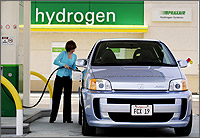
How does a hydrogen fuel cell work? They split hydrogen atoms into protons and electrons to generate electricity.
There are several different types of fuel cell. This is how a basic hydrogen fuel cell works. The hydrogen is pressurized and fed into the storage tank. When the power is required, pressurized hydrogen is fed into the fuel cell. The fuel cell has 7 basic parts. Let’s look at them in the order that they are used. The hydrogen fuel is fed in to the battery and encounters a platinum catalyst. When the hydrogen encounters the platinum, it separates into protons and electrons. Platinum is used because hydrogen sticks to platinum, making it easy to split it up, but the bond isn’t so strong that the hydrogen can’t get free again. Once the hydrogen has been broken into protons and electrons, we have the next three parts of the fuel cell. In the same way as all batteries, one is the negative anode and the other is the positive cathode. There is a membrane in between them. The membrane will only let the positively charged protons pass. The negatively charged electrons are forced away from the anode and around a circuit, generating an electric charge that powers the motor. At the other end, the electrons and the protons recombine at the cathode and are mixed with oxygen, which is fed into the other side of the fuel cell. The hydrogen and the oxygen form water, which flows out of the fuel cell. In a general hydrogen fuel cell motor, multiple power cells are combined to produce the required amount of power. As long as the fuel cell has a source of hydrogen and oxygen, it will produce electricity forever.
How do you create the hydrogen that goes into the fuel cell? Hydrogen is the lightest of all the elements, and is the most abundant element in the universe. It makes up most of the sun and the sun produces its energy by fusing hydrogen atoms and creating helium under enormous pressure. Hydrogen is the most abundant element, but it is almost always found combined with something else. That means, to get hydrogen, you need to separate it from the thing it has combined with. On Earth, one of the most common sources of hydrogen is in water. One way to separate them is to use electricity. An electric current can separate hydrogen and oxygen, but it requires more energy to separate the atoms than would be generated by the hydrogen fuel cell.
How does a hydrogen fuel cell work in a car? A hydrogen fuel car works in almost the same way as an electric car, except the electricity is created on board. An electric car stores electricity in the battery when it is charged. When it is driven, the electricity is passed to the motors on the wheels and the car drives. A hydrogen fuel cell car does exactly the same thing, but the electricity is produced by the hydrogen.
There are several advantages and disadvantages to a hydrogen fueled car. Advantages first. They are silent and they produce no emissions. The only byproduct from a hydrogen fuel cell is water. They don’t lose power in cold or hot weather, which can be a problem for electric cars. They can be refilled as quickly as current gasoline cars, while electric cars can take up to an hour. They have a greater range than electric cars.
So, why aren’t we all driving hydrogen fuel cell cars? There are several significant disadvantages that need to be overcome first. Hydrogen is very costly to produce and requires more power to get it than can be obtained from it. If the power used to separate oxygen and hydrogen comes from fossil fuels, then it is just as harmful to the environment as a gasoline car. The fuel cells have a platinum catalyst, which is an extremely expensive metal. The hydrogen as to be pressurized, which makes the cars more expensive to make and hydrogen fuel stations difficult to produce. The fuel nozzle at a fuel station would have to have a foolproof seal. Hydrogen is also highly flammable.
However, that doesn’t mean that hydrogen fuel cell cars are impossible, just that they are difficult at this moment in time. Toyota believes that hydrogen fuel will be more successful than battery powered electric cars and they are currently investing a lot of money into research. They plan on releasing a liquid hydrogen powered car in 2023. That in itself will create more problems because liquid hydrogen has to be kept at below -253˚C. Toyota must know what they are talking about and that fills me with hope. There are an estimated 1.5 billion cars in the world, all of which produce greenhouse gasses. If they could all be converted to hydrogen, it would be so much better for the environment. Hopefully, it will happen in my lifetime.
Sources
https://www.energy.gov/eere/fuelcells/hydrogen-production-electrolysis
https://afdc.energy.gov/fuels/hydrogen_production.html
https://afdc.energy.gov/vehicles/how-do-fuel-cell-electric-cars-work
https://www.energy.gov/eere/fuelcells/fuel-cells
https://en.wikipedia.org/wiki/Fuel_cell
https://en.wikipedia.org/wiki/Proton-exchange_membrane_fuel_cell
https://driveclean.ca.gov/hydrogen-fuel-cell
https://www.japantimes.co.jp/news/2023/01/05/business/corporate-business/toyota-hydrogen-fuel-car/
https://www.energy.gov/eere/fuelcells/liquid-hydrogen-delivery
